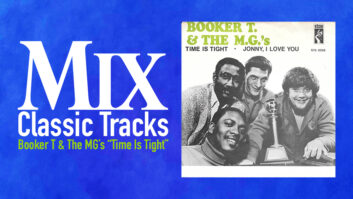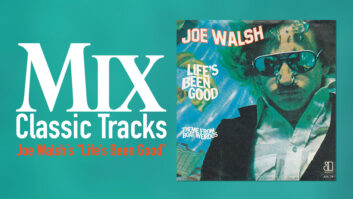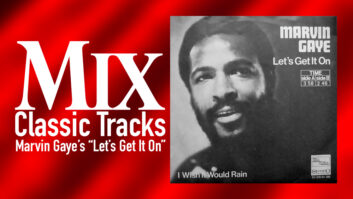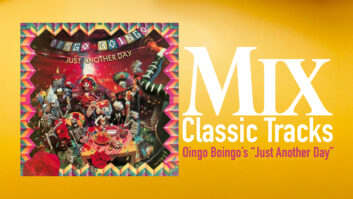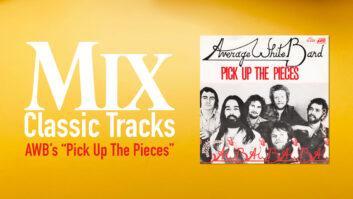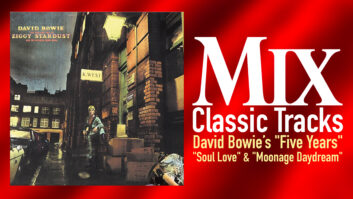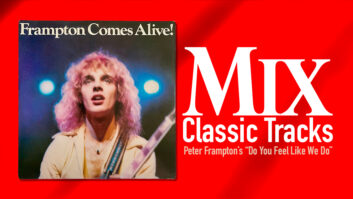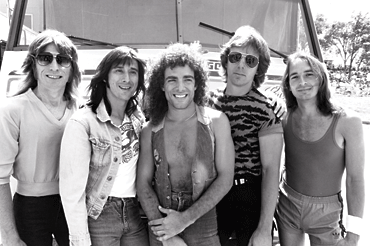
In 1981, Journey was coming into its own. Although the Northern California unit had been together since 1973, it wasn’t until a couple of years after hiring lead vocalist Steve Perry in ’77 that the band had its first Top 20 hit with “Lovin’, Touchin’, Squeezin’.” By 1981, the perfect combination of musicians and writers was finally in place, with Perry, founding guitarist Neal Schon, Steve Smith on drums, Ross Valory on bass and newest member, keyboardist/songwriter Jonathan Cain (replacing the recently departed Gregg Rolie). The album they were about to embark upon, Escape, would garner them great success, with three Top 10 hits: “Who’s Crying Now,” “Don’t Stop Believin’” and “Open Arms.” The first and last of those were beautiful ballads, but “Don’t Stop Believin’” became an anthem of sorts, with its signature piano intro, the escalating locomotive guitar part and the pounding drum track with a searing vocal on top. It would become one of the group’s signature tunes and helped make Escape the band’s true break-out album.
Before tracking that album, Journey worked 11-to-6, five days a week in an Oakland, Calif., warehouse, writing and then rehearsing the new material. “It was a great time with me and Steve Perry,” Cain says. “He could have said, ‘Screw you, I’m going to write this, you’re the new guy, get out of here,’ but he didn’t. It was the wonderful thing of ‘What can we do together to make this better?’ It was probably the third or fourth song I wrote with them.
“I brought in the chorus, the last out-chorus — ‘Don’t stop believin’, hold on to that feelin”, and I think I had ‘streetlights people.’ I showed it to Steve [Perry] and I believe Neal [Schon] came up with the bass line. It was Steve Perry’s idea that, since it was my chorus, I should chime in with some sort of piano thing that sounded like we were going somewhere. I put that [strident intro] on top of Neal’s bass [motif] line, and then Steve started scatting on that. Steve looked at Neal, and said, ‘Okay, now you have to sound like a train’ and he did that guitar in between the verses — the 16th arpeggio.
“From that point,” Cain continues, “we wanted to build different sections and we felt the song should have two choruses, so we did a sub-chorus, if you will. Our goal was sort of to build the song backward to get to the ‘Don’t Stop Believin”, which were the only lyrics we had. Then came the [other] lyrics. Once we got the shape of the song, Steve and I took cassettes home, with Steve just singing syllables. When we heard Neil’s train thing, we said, ‘What if two people were trying to get away from the place they grew up and they were taking a midnight train going anywhere.’ I always loved that Gladys Knight song, ‘Midnight Train to Georgia.’ Steve and I thought it would be really charming if we had just a small-town girl and then a city boy. I told Steve about living on Sunset Boulevard, so the middle section, which I’ll call the pre-chorus — ‘strangers waiting up and down the boulevard, their shadows searching in the night’ — was about Sunset Boulevard back in the ’70s. I got that from seeing that every night in Hollywood — people coming to L.A. looking for their dream. That’s the premise of the song. We felt that every young person has a dream and sometimes where you grow up isn’t where you’re destined to be. We really felt that we had nailed something fun, and Steve had fun singing it.”
However, the day they were set to record it at Fantasy Studios in Berkeley, Calif., Perry had a cold, so he couldn’t record live in the studio with the other musicians as he usually did, and he opted to go home. The others proceeded without him, but found the song’s tempos and various sections difficult. “It was a tricky song because it was my tempo matching the band’s tempo when they came in,” explains Cain. “They couldn’t be faster than me or slower than me, and when I came in on the second verse, I had to nail the similar tempo that was just happening, all by myself. Ross [Valory] and I had to play in sync because we were playing the bass lines together, so we couldn’t rush each other or slow down on each other. So they turned on one of those verbal click tracks. We did find that it helped us gather ourselves together, so we played with it for about 20 minutes. Then I looked at [co-producer/engineer] Mike Stone, and said, ‘Turn that thing off,’ and when the click track went off, we got it on the first take. Perry sang it pretty quickly the next week.”
Cain still remembers one of the effects that was employed on Perry’s vocal, a trick he learned from producer Keith Olsen: “We had an old 2-track Dolby processor, which we pulled cards seven and three out of. This gave a sort of high-end sheen. We brought the output of the vocal back to another fader and summed the compressed signal with the Dolby signal about 60/40 to a track. We printed it that way. Risky stuff — but it became Steve Perry’s sound.”
Kevin Elson, who teamed with Mike Stone (of Queen fame) to produce and engineer Escape (Wally Buck also engineered), recalls working on a Neve 8108 console with a Studer A800 24-track tape machine. “The only thing digital we had was a Prophet [synth],” remembers Elson, who still mixes Journey’s live sound. “All the keyboard parts were on a Roland Jupiter and Prophet. The album was recorded live. If you listen to guitar solos on Journey records, you never hear rhythm guitars blasting under it. Neal always does his solos when we’re tracking. He goes right from his rhythm guitar parts into the solos, just like he would play live. Jonathan played his piano live. And even vocals, there would be complete vocal takes we’d keep a lot of. Perry would always make things better, but there were some that were so good that we’d keep it.”
As for the song’s instantly identifiable percussion track, “Steve Smith created that incredible drum beat,” says Cain. “In the pre-chorus — the strangers waiting — there’s this lovely thing he does with a little splash cymbal that has a china bell on it. He ended up coming up with the syncopated beat with the toms that was brilliant.”
Smith worked all that up at home. “I played a very straight rock drum beat,” he says. “I would take the recordings home and listen to them in my head. Sometimes it sounded correct to keep it simple, but on that tune, I started hearing melodic tom-tom additions, the bell of the ride cymbal — the sort of drum melody that would be a foundation for the song, but also add structure to the tune. Technically, in the drumming sense, to play what I was hearing, I had to play that particular tune open-handed: my left hand on the hi-hat and my right hand playing the backbeats on the snare drum. Normally, I don’t play that way, but I did on that particular tune, so it freed up my right hand to play melody between the snare and the tom and the bell of the ride cymbal. I developed the part like the tune evolved. My drum part had four parts to it. In the early part of the tune, it was pretty basic, then I added a little more, and by the end of the tune, I had a very complex snare drum, tom-tom, bell of the cymbal melody, while the bass drum and hi-hat were pretty straight-ahead, playing four on the floor with the bass drum and eighth notes on the hi-hat with my left hand.”
Smith recorded his part in a drum booth in the corner of the studio with an AKG 414 (snare), a Shure 57 (top and bottom), an AKG 451 (hi-hat), Sennheiser 421s (toms), and a Neumann U87 and U47 (bass). “It was a tight drum sound with certain plates and things on it,” recalls Elson. “We used a lot of EMT 250, and Fantasy had a couple of natural chambers and probably four different EMT plates, and we used a combination of those. A lot of that sound was the EMT 250. Steve would come in, tune his kit up, we’d get the mics up, and within three hours we’d be ready with the sounds and ready to go with him. We could put a mic on there and not have to think about gating and tweaking and do this and do that. That big sound was really so much of how he tuned his drums and very little of what we did.”
Cain says he’s pretty sure that Schon used a Les Paul and a Strat through Marshall amps on the cut, while Cain played a Steinway and an ARP Omni: “A little cheesy keyboard I had from The Babys, which I played those little stabs with.” Elson says piano mics were a U47 on the low end and a 414 on the top. For Perry’s vocals, he recalls using a U47, although he says Perry’s main mic was a Neumann M49. “The 47 had a little more edge on his louder vocals,” Elson says. “It would take a bit more of the sound pressure he was delivering. The 49 had more of that airy, crisp, almost throat distortion sound.”
The album was completed in four or five weeks and “Don’t Stop Believin’” made it up to Number 9. (“Open Arms” became Journey’s highest-charting single at Number 2.) Today, Elson says of the song, “Hearing it now, I have the same feeling I had when I first heard it in the studio — wow! The best memories I’ll ever have of that band is that group of guys. Everybody was so funny and quick. We all laughed a lot, there was a lot of teasing and joking. Steve Perry’s favorite saying was, ‘Let’s roll, let’s roll, time’s money, time’s money.’” Incredibly, that multi-Platinum album cost about $85,000 to make.
